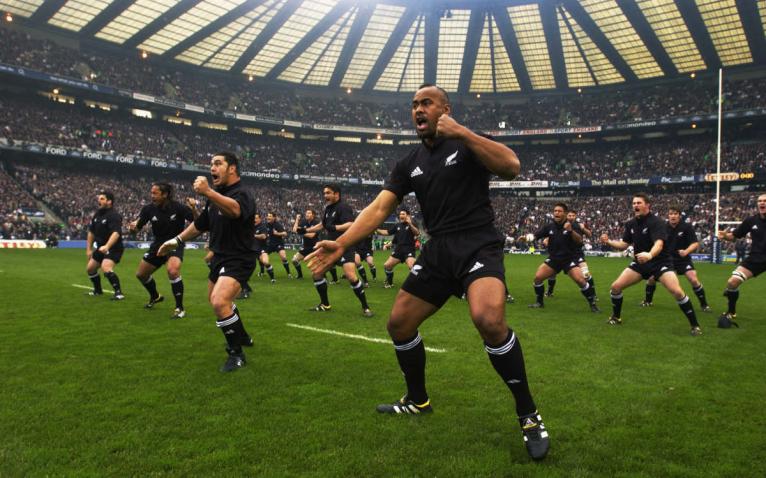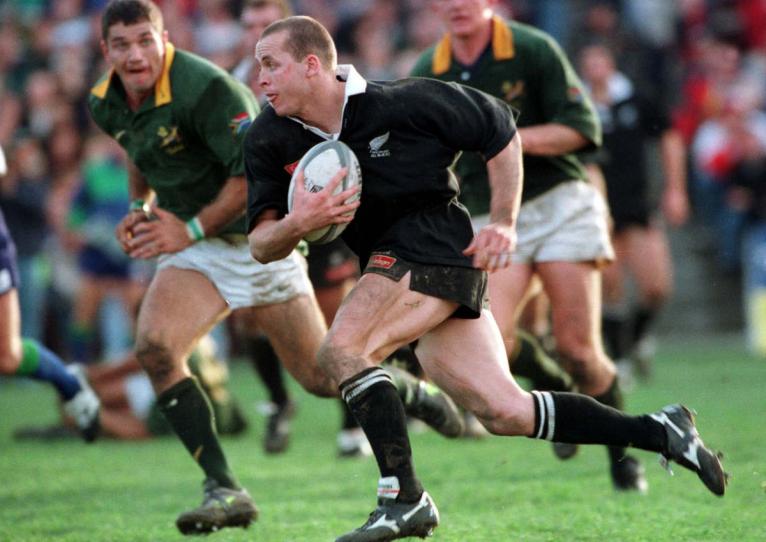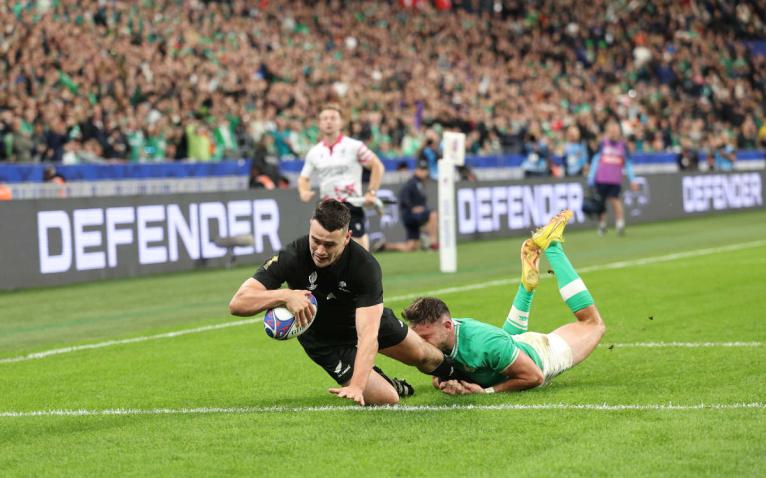Will Jordan has everyone consulting the record books to see just how far up the all-time try-scoring list he is now and what he will need to do to usurp Doug Howlett, who sits at the top with 49 tries.
The assumption is that Jordan is going to go way past the greats on that list and smash the 50-try barrier and set all sorts of new records.
Why wouldn’t he? In Turin on Saturday night, he played his 41st Test and scored his 38th try. It shifted him up one place on the all-time list – one try ahead of current team-mate Rieko Ioane and Jonah Lomu,.
But what makes Jordan’s numbers different, is the speed at which he has reached this exulted position. Ioane has played 80 Tests to score 37 tries, which means his ratio of Tests played to tries scored is 0.47.
Lomu played 63 Tests to score his 37 for a 0.59 ratio. Above them is Ben Smith, who scored 39 in 84 (0.46), Jeff Wilson on 44 – which came in 60 Tests (0.73) and, higher still, there is Christian Cullen on 46 tries from 58 Tests (0.79), Joe Rokocoko on 46 tries from 68 Tests (0.68) and Howlett at the top with a ratio of 0.79.

The best ratio from any player above Jordan on the list, belongs to Julian Savea who scored 46 tries in 54 Tests (0.85) and the lowest is Beauden Barrett – 45 tries in 134 Tests (0.33).
And this is what is prompting so much excitement about Jordan. His ratio is 0.95, which means he’s, statistically at least, on track to surpass Savea as the fastest player to score 40 tries for the All Blacks.
Savea scored his 40th try in his 46th Test, against Australia in 2016. But barely a year later he would play his last Test for the All Blacks – against the British and Irish Lions in the series decider.
He had a difficult night where he fumbled a pass in the first few minutes with the line at his mercy and missed a few easy tackles. He was dropped for the Rugby Championship, the news coming out on the day of his 27th birthday.
Going through the all-time list, the age of 27 becomes impossible to ignore. Cullen played his last game for the All Blacks just a few days short of his 27th birthday.
And going through the all-time list, the age of 27 becomes impossible to ignore. Cullen played his last game for the All Blacks just a few days short of his 27th birthday.
He was booming along as the greatest attacking fullback of the professional age, suffered a serious knee injury and never really recovered.
Wilson played his last Test for the All Blacks when he was 27. Capped at just 19-years-of-age, Wilson decided to call it quits with rugby to try his hand again at cricket – he had played international cricket before he was selected to play international rugby.
Rokocoko – his last game was as a 27-year-old in 2010. Like Wilson he’d made his debut young – he was just 20 – and international rugby looked like a breeze for him until he turned 27 and suddenly he lost his explosive pace and the ability to beat defenders.

And sadly for Lomu, 27 was the age at which he could no longer hide his chronic illness that was destroying his kidneys. He too, was no longer an international try-scoring force once he turned 27.
Jordan, as fate would have it, turns 27 in February next year and the question that the data makes impossible not to ask, is whether he is going to be able to sustain his current try-scoring ratio once he reaches what has been a cruel age for outside backs in New Zealand.
Can he really continue to torment defences and score as regularly as he does, or will there be an inevitable slow down?
Judging by the way he played in 2024, and the way he’s played since he came into the All Blacks, there is every reason to believe Jordan will still be splitting defences and bamboozling defenders into his 30s.
What’s different about him is the range of weaponry he has at his disposal. He is lightning quick, yes, but what makes him seem quicker on the field is his anticipation and innate ability to read where space might be.
It would be fair to say that Jordan is not just a spectacular try scorer, but also a spectacular scorer of spectacular tries, none more memorable than the one he scored in the 2023 World Cup quarterfinal, blasting off Richie Mo’unga’s shoulder.
His show reel contains few tries where he was simply on the end of a great backline and had an easy run in to score. His portfolio is loaded with brilliant, individual tries where he had to inject himself into proceedings and do something magical to score – a brilliantly timed run close to the ruck, or a chip and chase started from an impossible position.
It would be fair to say that Jordan is not just a spectacular try scorer, but also a spectacular scorer of spectacular tries, none more memorable than the one he scored in the 2023 World Cup quarterfinal, blasting off Richie Mo’unga’s shoulder.
“We practised that throughout the week,” Mo’unga would reveal. “The move wasn’t actually made for me, it was made for Will Jordan on the inside and I saw the two defenders hold on him because obviously, he’s a big threat at the line.
“If you’re in a black jersey it’s a good start” 🖤
Watch @dallaglio8 catch up with the @AllBlacks‘ Will Jordan 🇳🇿 pic.twitter.com/nYHOd8NjvG
— Rugby on TNT Sports (@rugbyontnt) November 20, 2024
“What people don’t usually see is his ability to understand the game of rugby. You see it in games where he pops up at the right time. His anticipation is probably his biggest strength, that and his speed.
“He is able to read plays ahead and see where the ball is going to get to. And he sniffs out any opportunity. He has a huge, huge future.”
Arguably the most compelling evidence to support the contention that Jordan isn’t a finisher so much as a creator/finisher, is the number of teams he has scored against.
Some All Blacks wings have boosted their totals by scoring a hat-full against emerging nations at the World Cup. But Jordan’s tally has been mostly built by scoring against most of the top dogs in the world game – and tries have come against South Africa, Ireland, England, Australia, Argentina and Fiji, and he just needs to score against France and Scotland to ensure he has touched down against every nation currently in the top 10.
Jordan shifted to fullback mid-way through this year, which was partly because the coaching panel wanted to shift Beauden Barrett to first-five and because head coach Scott Robertson believes it is the 26-year-old’s best position.
But what is most likely to ensure Jordan doesn’t turn 27 and hit the wall, is that he has a wider set of basic skills than the likes of Lomu, Rokocoko, Howlett and Savea, and therefore, he has greater potential longevity as a Test starter even should he lose a fraction of his pace as he ages.
Jordan shifted to fullback mid-way through this year, which was partly because the coaching panel wanted to shift Beauden Barrett to first-five and because head coach Scott Robertson believes it is the 26-year-old’s best position.
Robertson used Jordan at fullback throughout his time at the Crusaders and the All Blacks coach is of the view that Jordan can be better utilised as an attacking weapon when he wears No 15 – a point that was proved correct after his protegee produced a mesmerising performance against Australia this year, just two Tests after making the switch from the wing.

“He created a lot,” waxed Robertson after the 33-13 victory. “When he gets the ball in hand, his angle changes, his step, he had a lot of players [beaten] with just how he moved his feet.”
Jordan, as he showed against England and Ireland is improving as a high ball catcher, kicker, defender and play-maker, and against France in Paris, he was willing to pop up at first receiver more often than he previously has and make decisions about facilitating the attack.
None of this will necessarily make him a more prolific try-scorer, but it will mean that he can develop into a multi-skilled fullback and hold his place in the team for many more years, and there is a statistical truth that the longer his career lasts, the higher the probability he will smash all try-scoring records even should his strike rate start to slow.
Robertson in assessing Jordan’s 2024 season, says: “He can finish on the wing he can create through his timing, his backfield cover and his kicking and he can really run the game and his body is good, so I am really pleased for him.”


This website needs an article on Sevu Reece being busted for drunk driving after being asked to leave a house for being disrespectful to its guests. Class behaviour… at least no women were hurt this time round. No dickheads policy you say?
I love a good scandal, but I’ve got other sports for that. Rugby players don’t do great scandals.
I can appreciate Sevu having a go, but the NRL has got Ezra Mam who did coke and drove into a car that had a mum and a kid in it.
THATS a scandal!
Todd Carney peeing in his own mouth, Mitchell Person simulating carnal relations with a dog… great entertainment.
What’s rugby got? Haven’t seen anything decent since Zac Guildford.
So many Rugby players have alcohol problems, it's normalised in the professional scene. Don't need articles on that, would rather focus on the sport itself.
As long as he remains injury free, Jordan will break the record.
The age of 27 is meaningless.
Doug Howlet did not slow down at age 27, he signed a contract with Munster and was no longer eligible for AB selection
Jeff Wilson did not slow down at age 27, he left rugby to play cricket.
Jonah Lomu kidneys tragically gave out on him due to illness.
Chritian Cullen had a series of knee injuries.
Julian Savea and Joe Rokocoko ate themselves out of a jersey with significant weight gains.
Hell, take Telea for example... debuted at 26 last year, and is still in excellent form at 27.
27 = glue factory w speed wingers....
Factually incorrect.
Jordan is a fantastic player no doubt. I reckon he could easily play into his 30's with great effectiveness. The problem is the All Blacks discard wingers at a very young age in favour of the next hot talent off the block. This is because the skillset, finishing quality and standards set by backs in that country is very high. The good news for him is he has found a new home at full back and with his physical attributes could play there for years to come. Lets see how his career unfolds but I reckon he will easily bust that record.
He needs a better skillset to be a 15. kicking...And deciding when to kick...are vital skills he lacks.
Short answer? No. That pace is central to everything in his game, that goes through his head. We saw in the last week or two him try and pin his ears back. But his real trouble, is of course a young Will Jordan coming along and taking his place.
I think this is really the next stage of his career, extending it by becoming more round. I also like Mark Tele'a on the right wing more, with his more recent recent record of 13 tries from 19 games and ability to get much better given his recency.
F%ck right off Razor. Pick an extra forward instead.
You do realize Jordan scored 7 tries in 9 starts this season. That is a higher strike rate than Tele'a in 2024.
If he evolves to be a player that works hard for everyone else around him, he will be here for a while.
If he only ever gets A into G when it’s on for him personally then he’ll get over taken.
Probably by Rueban Love who will play possessed next year.
Nah, Love's great but you obv have never watched Jordan closely. Easily best FB in the world rn, Fassi closely behind.
Makes his tackles, sometimes slots in at 1st or 2nd reciever, unmatched pace, and crazy vision for setting up tries. Why do you think he is always in the right place at the right time?
Easy to look at it statistically.
The end comes very quickly for players who rely on their acceleration. Virtually every All Black winger to play in the last 20 years are all great examples of that. One year you're the best in the world and undroppable, 2 years later you're coming off the bench for your NPC team.
Based on the way Jordan played this year at 15 I don't see him being part of the 2027 World Cup. His main attribute is his acceleration which unless he is a genetic freak like Cheslin Kolbe will desert him in the next year or so. Maybe his game will develop more but he is not currently someone who can switch in and out of a playmaker role like DMac. Knowing All Balcks coaches they will probably convert him to a midfielder!
Speed genes are strong in the Kolbe family his cousin Wade van Niekerk is the world 400m and Olympic record holder and has run close to 10 for the 100m.
Except Jordan doesn't rely on his acceleration. His true strength is knowing which support lines to run, and when to appear. His speed and acceleration is just the icing on the cake. Let's not forget Beauden Barrett was still scoring his signature intercept tries at 30 years old, despite losing much of his acceleration.
It's different for everyone. MNS never had pace to start with. Savea just kept dropping the ball. The key example I believe is duration. Many of these players were gifted and asked to be at a high level before they were 20 yo, so 8 years of performing at your best is a pretty long window to be fair.
That's not funny Nickers. You think he should just be happy falling by the wayside? I don't think he has the desire to add bulk but I'd love to see that switch like Narawa has. Narawa should have been the 15 holding Jordans jersey this year (after Pero got injured) too.